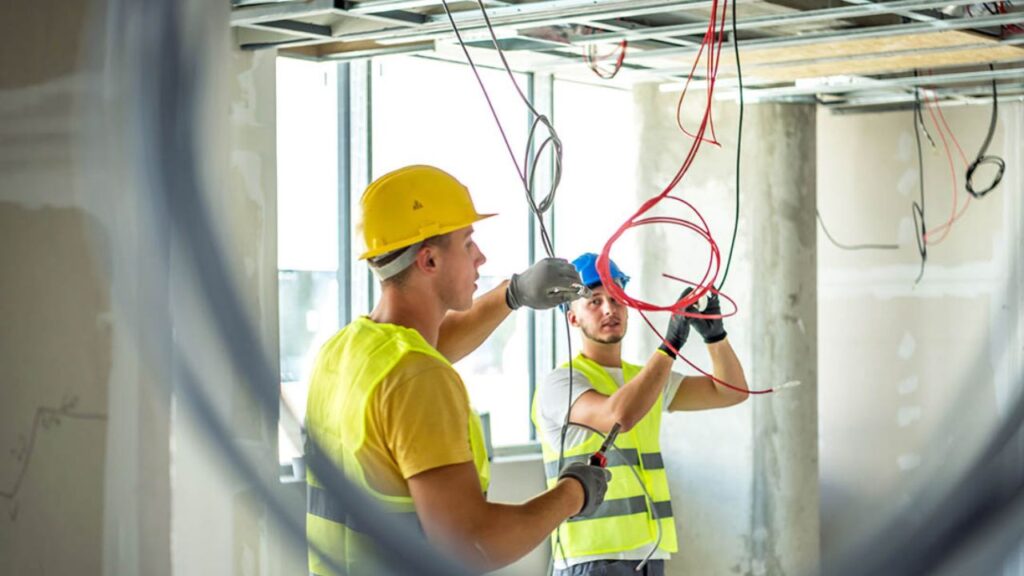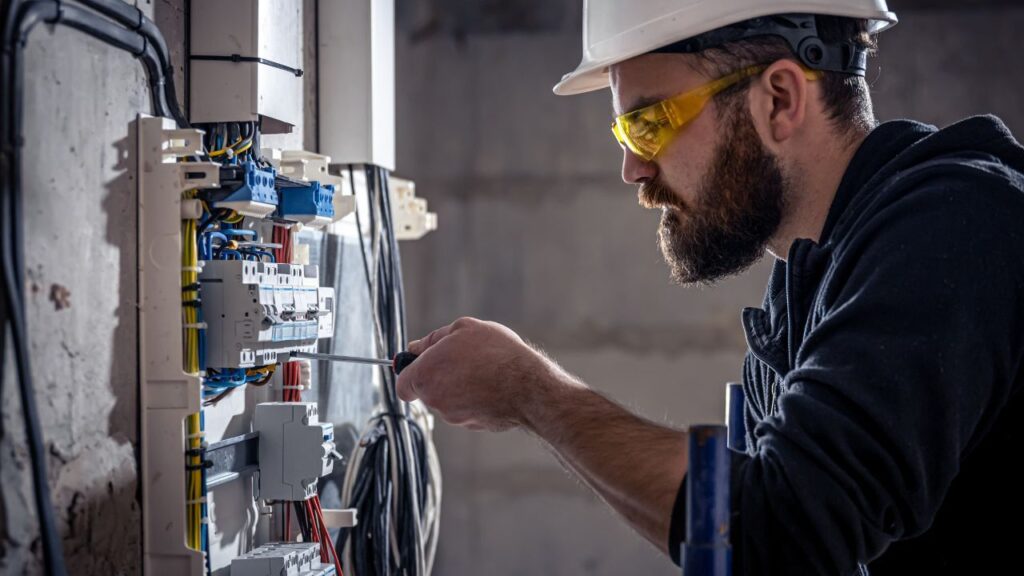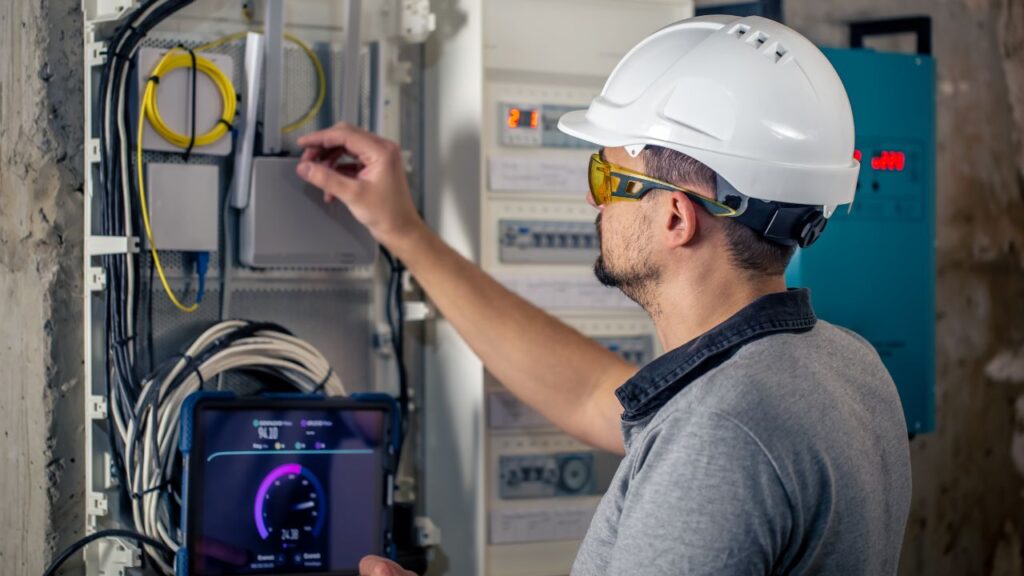A Wining Cost Estimate
That Helps You To Win More Electrical Construction Projects

Accurately estimating electrical job costs is key for success. Factors like complexity, location, and materials used can affect it. Understanding commercial electrical cost estimation helps contractors make detailed, transparent quotes and manage finances.
Analyzing the project’s scope and determining electrical needs is a must. This may include using blueprints or visiting the site. Permits, labor costs, and material expenses must be considered too.
The right tools and equipment should be selected for the job. Quality, rental fees, and purchasing costs should all be taken into account. Keeping track of market trends in pricing helps adjust estimates for inflation and reduced prices.

Overheads such as transport and licenses must be accounted for to prevent losses from insufficient billing. Refining methods with each project and adjusting expenses helps maximize profits.
Pro Tip: Documenting expenses for future estimates and budgets is a must!
To factor in the cost estimation for your commercial electrical project, consider the varying elements that influence its overall expenses. Size and complexity of the project, type and quality of electrical equipment, location and accessibility of work site, labor costs, and local regulations and permits are the key sub-sections to focus on for a successful evaluation of your budget.

Size and complexity are big factors when it comes to estimating the cost of commercial electrical projects. Bigger and more intricate projects require more labor, materials, and specialized equipment, so they are more expensive.
The following table lists the factors that can increase the costs:
Location, deadlines, and scope of work also affect cost estimation. It’s essential to communicate with customers about their needs so that you can tailor a solution that fits their budget and still yields successful outcomes.
I remember working on a huge commercial electrical project where we didn’t account for the necessary specialized equipment. This caused more delays and higher costs than we had originally predicted. That experience taught me that accurate cost estimation plays a big role in project success.
Bottom line: make sure your electrical equipment is up to par or you may get a nasty shock.
Considering electrical equipment for a commercial project can affect cost estimation. It’s important to consider the type and quality of equipment. We’ve listed common types and their quality levels in the table below. This includes voltage capacity, expected lifespan, energy efficiency ratings, and safety features.
Type and Quality of Electrical Equipment
Type of Equipment | Quality Level | Voltage Capacity | Lifespan (years) | Energy Efficiency Rating | Safety Features Required |
|---|---|---|---|---|---|
Transformers | Premium | Over 35 kV | 25+ | A++ | Fused Secondary Overload Protection |
Bulk Cables |
We help contractors find new customers with high-converting websites and locally targeted niche-specific lead-generation programs. You’ll never need to worry about running out of work again! We focus on quality over quantity with our leads for contractors.
Other factors to consider are installation timeline, labor fees, government regulations, and potential faults. To ensure success, detailed planning is necessary. It is also important to note that the type and quality of equipment must meet government standards. That way, everyone involved enjoys long-term positive results. Electricians in remote areas can charge more for their work due to the extra effort. So take advantage of that!
Geo-location and access to a worksite are imperative when it comes to commercial electrical cost estimation. These affect transportation costs, and the availability of resources like electricity, water and local labor markets. Accessibility of the work site can also affect the degree of difficulty.
Factors | Impact on Electrical Cost Estimation |
Geographic Location | Transportation Costs, Access to Resources |
Accessibility of Work Site | Level of Difficulty and Complexity of Project |
Environmental elements, such as weather, natural disasters and geographical hazards, may increase costs. Plus, each country has distinct regulations that must be considered.
A company representative experienced a difficult project in a remote area with restricted access roads. This led to extra transportation costs and longer installation times, resulting in higher labor expenses than expected. Electricians charge by the hour, so the longer they take, the bigger the bill will be.
Labor costs play an important role in estimating commercial electrical prices. Here are 3 key points:

These are only a few of the uncontrollable variables that affect cost estimates. To make a good decision about the right electrician, understanding these points is necessary. You can save money in the long run by picking wisely.
Pro tip: Choose an experienced contractor who has done similar projects before. They can estimate commercial electrical cost more accurately than someone with less experience. Getting a permit for commercial electrical work is difficult. It’s like navigating a maze with walls made of red tape. You need to go through bureaucracy to find your way out.
Electrical contractors need to comply with local regulations and get the right permits for estimating commercial electrical costs. Non-compliance can mean penalties and legal issues. Delays in permit acquisition lead to project management problems, like extra costs and extended timelines.
It’s important to consider regional laws, codes and locations that may impact the cost of the project. These can include labor rates, inspection needs and specialised equipment. Some places can be super strict, like a contractor who was estimating a 50-storey building in the middle of a big city. He had to follow strict limits on working hours, which added labour costs and overtime payouts.
To avoid costly outcomes, contractors must factor-in regulations and permits from the start. Estimating commercial electrical costs is like trying to predict the weather in Scotland – you never know what you’re gonna get!

To estimate the commercial electrical costs accurately, you need to use the right methods. In order to streamline the process, “Methods of Commercial Electrical Cost Estimation” with “Estimate Cost of Materials and Labor, Use of Electrical Estimating Software, Cost-Plus Pricing Method” as solution will help.
Electrical Cost Estimation entails predicting the expenses of both the materials and labor needed to finish a commercial job. To estimate the cost, one must calculate each component’s cost separately and add them up.
In the table given below, we have presented an in-depth analysis of Material and Labor Costs related to Electrical Commercial Cost Estimation.
Component | Material Cost | Labor Cost |
|---|---|---|
Wiring | $10,000 | $3,000 |
Circuit breakers | $2,000 | $500 |
Fuse Box | $1,200 | $300 |
Electrical Panels | $8,000 | $2,500 |
Outlet Replacement | $3,000 | $800 |
As seen above, different components such as wiring, circuit breakers, etc. incur separate material costs depending on their requirement. On top of that, the labor cost to perform those tasks differ based on complexity.
Other factors impacting Electrical Commercial Cost Estimation include Local & State Regulations that must be met as well as special Equipment Costs for the specific project.
The history of this estimation technique dates back to Robert Gifford who first introduced it during his time at IBM in 1955.

Initially used for the hardware estimation expenses connected to computers, it later found use in almost every commercial domain, including electrical estimation.
No need for a crystal ball – use electric estimating software to predict the cost of your commercial venture!
Software for estimating electrical costs is becoming more popular in businesses. For example, a table can be created showing the software, its price, and features. Such as:
Software | Price | Notable Features |
|---|---|---|
Accubid | $1,000 | Real-time updates |
ConEst | $900 | Automatic calculations |
McCormick | $1,200 | Customizable templates |
Despite the speed of software, accurate data input is still essential for accurate results.
Pro Tip: Remember to regularly update and maintain your electrical estimating software for optimal performance and accuracy.
Maximize your electrical construction business’s potential with our competitive financing options

Comprehensive electrical cost estimates are vital. ‘Cost-Plus Markup Pricing Strategy’ is one way to do this. Calculate the cost of materials, labor, overhead expenses, then add a markup percentage to find the final cost.
For an example, create a table showing all costs in an electrical job. The columns include: materials, labor hours, wages, overhead expenses, and profit margin. Input the real data to get the total.
This pricing strategy considers every expense during the project. Other methods only think about direct costs like materials and labor.
Commercial electrical projects need practical estimates to stay profitable. Without relevant cost estimation, businesses can overspend and miss out on returns. Cost-Plus Markup Pricing Strategy is a great approach. Better to estimate high and be pleasantly surprised than low and bankrupt.
To ensure accurate commercial electrical cost estimation with useful tips, conduct a thorough site survey, use past project data, consider contingency planning, and keep accurate records. These sub-sections will provide you with effective solutions to make your commercial electrical cost estimation process more accurate and efficient.
Accurately estimating commercial electrical costs needs an in-depth examination of the site. To do this, follow three steps:

It’s also important to remember hidden expenses. These can include weather-related damages or worn-out components. Lincoln said “If I had 8 hours to chop down a tree, I’d spend 7 sharpening my axe.” Estimating electrically based projects needs accuracy to have better outcomes. It’s like a game of memory- use past project data, or suffer the consequences.
Historical data from past electrical projects can enhance accuracy in commercial electrical cost estimation. Analyzing costs, including materials, labor, and equipment expenses from past projects, can provide an informed and precise estimate for the current project.
To prove this, consider the table below:
Project | Materials Cost | Labor Cost | Equipment Cost |
|---|---|---|---|
Project A | $10,000 | $5,000 | $2,500 |
Project B | $12,500 | $7,500 | $3,000 |
Project C | $8,750 | $6,250 | $2,000 |
Comparing this data to the upcoming project scope and requirements, it is possible to make a more accurate budget prediction. For example, if the upcoming project requires similar materials as Project A but higher labor requirements like in Project B, then both datasets can give an idea of what the budget will look like, including wiring inspection costs.
Past project data can also be used to identify fluctuation in raw material rates. This helps to source stocks at the best prices, considering lead times.
In a 2019 study by Dodge Data & Analytics of nearly 200 construction firms, those who used Advanced Estimating Technology (AEC) had a better chance of winning contracts. Those who used estimator softwares reported a 10% decrease in reflows and a 50% decrease in construction time across multiple sites.
It’s always better to plan for the worst and hope for the best, especially when it comes to electrical costs.
Discover the transformative power of hiring professional contractors for your project. Unlock a wealth of expertise and experience to ensure success. Get started today and see the difference!
Estimating commercial electrical costs is key. Unexpected issues might happen during the project. Such as unknown site conditions, work scope changes, or delays from outside factors.
To be prepared, do a thorough assessment. Evaluate the site, review plans, and find any problem areas. Then, build a contingency plan. It should list potential scenarios, guidelines for responding, and who is responsible. Include a communication strategy to update all involved.
Contingency planning is about being proactive. Anticipate the problems and make a plan. That way, you can keep your project on track.
Real Talk: During a construction project, bad weather caused major delay. But, due to a sound contingency plan and communication, the team adjusted in time. Don’t let wiring shock you- be ready for the bill.
Having precise records is key for electrical cost estimation. This is to track materials and labor expenses and to avoid errors. Here’s how:
Keep the records up-to-date and provide access only to relevant personnel. Doing this minimizes errors, provides reliable progress reports, and increases transparency.
You must also consider the criterias prescribed for each project. Additionally, automated doc systems and centralized software can streamline operations and reduce human error. These methods boost financial reporting once you assess your business needs.
To help you reduce commercial electrical costs, the section on Strategies for Reducing Commercial Electrical Costs with sub-sections like Proper Planning and Design, Use of Energy-Efficient Electrical Solutions, Regular Maintenance and Upgrades, and Negotiation with Electrical Suppliers and Contractors has been included in The Complete Guide to Commercial electrical Cost Estimation. These sub-sections will provide you with effective solutions to lower your commercial electrical costs.

Strategic Arrangement and Blueprint is the key to cost reduction in electrical commercial settings. This phrase explains how proper planning aligns with reduced costs. Creating a blueprint is necessary to map out power needs, wiring pathways, and identifying load demands. Failing to understand these aspects could lead to higher energy expenses.
Audits can identify inefficiencies. Appropriate tools make devices more efficient. Smart technologies should be incorporated into the strategic arrangement and blueprints for projects.
Train workers in best practices. Human Resource Development must incorporate all aspects related to electricity usage in the workplace. Efficient lighting systems use less energy and provide enough illumination. Retrofit buildings with adjustable light sensors or timers. Reduce HVAC consumption by sealing air leaks. Lower heating and cooling loads and maintain HVAC system efficiency.
Save energy, save money, save the planet – one smart energy-efficient stone!
Here’s a 4-Step Guide to help businesses with Regular Maintenance and Upgrades:
Businesses can also use alternative power sources. Solar panels and wind turbines can dramatically reduce energy bills. Consulting a qualified professional on energy-efficient strategies can also help save costs.
Regular Maintenance and Upgrades can reduce energy bills by improving efficiency and cutting repair expenses. It frees up funds for investing in other areas while helping shrink the carbon footprint of commercial buildings.
Negotiating with electrical suppliers and contractors is like trying to haggle with a robot – they have no emotions and always calculate in their favor.

Cutting Electricity Costs Through Contractor and Supplier Negotiations
Lowering commercial electrical bills? Negotiating with suppliers and contractors is essential! Here are some helpful negotiation skills:
Technique | Description |
|---|---|
Bundling | Buy more and save! Get discounts when you package multiple services. |
Leveraging Competition | Get competitive quotes from other suppliers or contractors, and use them to score a better deal. |
Timing | Negotiate during non-peak seasons when there’s less demand. |
Besides these, communication is key. A good relationship with the supplier or contractor can lead to more favorable terms and conditions. Negotiation is not only about price. Delivery schedules, payment terms, warranties, and service level agreements can all be negotiated. Negotiations have been used for many years to save big on commercial electrical costs. It’s not as thrilling as winning the lottery, but it sure beats crying over a high utility bill!
It’s vital for estimators to accurately calculate the cost of commercial electrical projects. Follow this article’s guide to guarantee your estimates are comprehensive and accurate.
Pro Tip: Detailed and precise estimates can create trust with customers, leading to long-term relationships and more business opportunities.
Electrical cost estimation is the process of determining the approximate cost of electrical installations, repairs, and maintenance in a commercial setting.
Factors that can influence the cost of electrical work in a commercial setting include the complexity of the installation, the size of the building, and the type of materials used.
The cost of electrical work is typically calculated based on the size and scope of the project, the type of materials used, and the hourly rate of the electrician or electrical company performing the work.
A good electrical estimator should have experience working on similar projects, be knowledgeable about current electrical codes and practices, and be able to provide accurate cost estimates within a reasonable timeframe.
To ensure accuracy in your commercial electrical cost estimation, be sure to provide the estimator with as much detail as possible about your project, including the type and size of the building, the scope of work required, and any special requests or considerations that may affect the project cost.
Here I am going to share some steps to get your electrical construction cost estimate report.
You can send us your plan on info@estimatorflorida.com
Before starting your project, we send you a quote for your service. That quote will have detailed information about your project. Here you will get information about the size, difficulty, complexity and bid date when determining pricing.
We do electrical construction cost estimating and prepare a detailed report for your project. At last, you finalize the report and finish the project.
561-530-2845
info@estimatorflorida.com
Address
5245 Wiles Rd Apt 3-102 St. Pete Beach, FL 33073 United States
561-530-2845
info@estimatorflorida.com
Address
5245 Wiles Rd Apt 3-102 St. Pete Beach, FL 33073 United States
All copyright © Reserved | Designed By V Marketing Media | Disclaimer
IMPORTANT: Make sure the email and cell phone number you enter are correct. We will email and text you a link to get started.
By clicking “I Agree” above you give Estimate Florida Consultin express written consent to deliver or cause to be delivered calls and messages to you by email, telephone, pre-recorded message, autodialer, and text. Message and data rates may apply. You are able to opt-out at any time. You can text STOP to cancel future text messages.